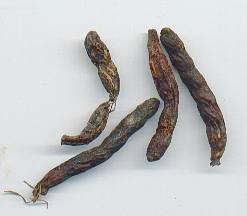|
|||||
|
|||||||
|
    An initiative of :Stichting Food-Info
|
| Food-Info.net> Food Products > Spices Negro pepper (Xylopia aethiopica)Plant familyAnnonaceae (custard apple family) Botanical synonyms-OriginTropical Africa (Ethiopia to Ghana) Used plant partFruits; they look rather like small, twisted bean-pods. They are dark brown, cylindrical, 2.5 to 5 cm long and 4 to 6 mm thick; the contours of the seeds are visible from outside. Each pod contains 5 to 8 kidney-shaped seeds of approximately 5 mm length. The hull is aromatic, but not the seed itself. Sensoric qualityAromatic, quite pungent and slightly bitter Main constituentsIn negro pepper fruits, the essential oil (2 to 4.5%) has been found to consist of ß-pinene, 1,8-cineol, a-terpineol, terpinene-4-ol, paradol, bisabolene and other terpenes. In other work, linalool (E)-ß-ocimene, a-farnesene, ß-pinene, a-pinene, myrtenol and ß-phellandrene were found, furthermore traces of vanillin and 3-ethylphenol (Journal of Agricultural and Food Chemistry, 47, 3285, 1999)
 Dried negro pepper fruits UseNegro pepper has been used as a pepper substitute in Europe, but with regular imports of black pepper from India starting in the 16th century, it mostly disappeared. In later times, negro pepper was only traded as a pepper substitute (or surrogate) in times of war and short supply; the last time, it was seen in Europe from after World War II till the 60s of the previous century. It is hardly available outside of the production countries nowadays. Source : www-ang.kfunigraz.ac.at/~katzer/engl/spice_welcome.html |
|
| ||
| Food-Info.net is an initiative of Stichting Food-Info, The Netherlands | ||||||